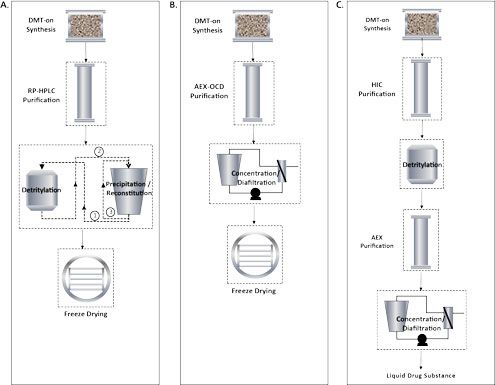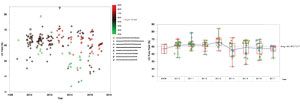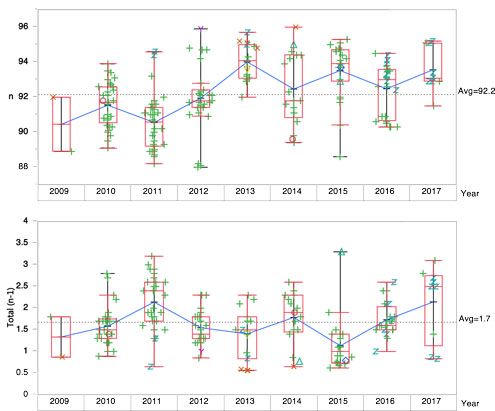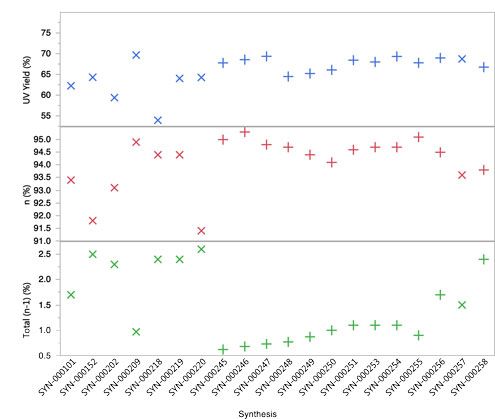Designing Commercial-Scale Oligonucleotide Synthesis
Consider current large-scale practices for oligonucleotide synthesis as a basis for improving commercial-scale platform strategies.
peshkova - stock.adobe.com

The strategy of targeting RNA to control processes affecting disease pathology has seen a flurry of clinical success. Regulatory approvals of Spinraza (nusinersen, Biogen), Exondys 51 (eteplirsen, Sarepta Therapeutics), Tegsedi (inotersen, Akcea Therapeutics), and Onpattro (patisiran, Alnylam Pharmaceutials) in the past few years highlight the relevance of the technology as a new platform for treating disease.
The manufacturing processes being used to produce several of these molecules are built on the solid-phase phosphoramidite approach developed by Beaucage and Caruthers more than 35 years ago. Since then, there has been significant improvement and optimization of the raw and starting materials, reaction parameters, purification, and isolation processes used for oligonucleotides and oligonucleotide mimics. The application of these improvements in large-scale (i.e., multi-kilogram batch) scenarios is becoming more common as more is learned about translating bench-scale methods to a commercial-scale manufacturing setting.
The oligonucleotide field, which is still in its commercial infancy, does not have decades of commercial-scale manufacturing experience on which to draw, but it is beginning to transition to this level of large-scale process experience, as evidenced by drug approvals and new plant capacity. The objective of this article is to provide a framework for developing and improving manufacturing strategies used for oligonucleotides, beginning with an overview of how oligonucleotides are currently synthesized at large-scale.
Some companies internalize their manufacturing capabilities, while others turn to contract manufacturing organizations (CMOs) for process design, scale-up, and implementation. Regardless, the manufacturing facility is most likely to be a multi-product one. There is not yet an oligonucleotide drug requiring significant enough quantities (i.e., metric tons) to warrant a compound-dedicated plant, but most of the companies involved in the manufacturing processes are banking on the success of the oligonucleotide platform to warrant further capital investment. Therefore, the recommendations in this article are directed toward the multiple-product facility where platform processes are paramount for rapid scale-up and minimal compound-specific process research.
Process overview
In its simplest description, oligonucleotide manufacturing consists of only a few, basic unit operations: solid-phase synthesis, purification, and isolation. The earliest syntheses of oligonucleotide drug substance were performed via solid-phase couplings on controlled pore glass (CPG) in sparged bed reactors. While sparged bed reactors are still common and practically useful in high-throughput and small-scale applications, the extensive amount of solvent wash and reagent excess required to accommodate that mixed-bed reactor design are not desirable in larger-scale operations where economic and logistical considerations are important.
Packed bed reactors (PBRs) and higher yielding polymeric, swellable resins (1,2) can accommodate the significant mass addition of a typical oligonucleotide (7 kDa). PBRs are used commonly outside the pharmaceutical industry in chemical applications in which a bed of solid catalyst is interacting with a liquid or gas reactant. Although the phases for oligonucleotide synthesis differ from traditional PBRs (i.e., liquid-solid vs. gas-solid), the same basic design principles apply. Characteristics of PBRs such as residence time distributions (3) and other fluid mechanical characterizations have been described recently (4,5). These characterizations represent an opportunity for incremental improvements in large-scale oligonucleotide synthesis.
Following solid-phase oligonucleotide synthesis, crude material is purified and isolated. Among the purification options being employed at large-scale are reversed-phase high performance liquid chromatography (RP-HPLC), ion exchange chromatography (IEX), and hydrophobic interaction chromatography (HIC). RP-HPLC and IEX are being used for several of the recently approved oligonucleotide therapeutics and thus have a proven record in commercial manufacturing. HIC is a recently described (6) and interesting addition to the toolbox because it operates on principles analogous to RP-HPLC but without the use of organic solvent. Despite the different principles of separation, the three techniques have the same gross effect on the crude mixture. That is, they remove shortmers (low molecular weight oligomers) that arise from incomplete coupling during synthesis or side reactions that lead to short cleavage products and longmers (high molecular weight oligomers) that arise from starting material-related impurities. Although there may be subtle impacts made to impurities closely related to the product (e.g., missing one nucleotide), the bulk of the purity improvement is from a reduction of impurities significantly shorter or longer than the parent molecule. Therefore, the rationale for choosing a purification technique will rest, in large part, on the previous experience, existing equipment, or a combination thereof at the CMO or company executing the large-scale work. For example, retrofitting an existing facility or repurposing equipment not rated for flammable solvent will almost certainly push the solvent-heavy RP-HPLC process to the bottom of the list and move the typically aqueous buffer systems of IEX and HIC to the top of the list.
Regardless of the purification technique employed, oligonucleotide must be isolated from the purification buffer and, in some instances, converted to the appropriate salt form. In nearly all applications, the final isolation step is designed to result in a solid form for logistical, stability, and operational convenience. Ethanol precipitation and ultrafiltration (i.e., diafiltration + concentration) are the intermediate isolation options, and freeze drying is almost always used for the final isolation. In comparison to ultrafiltration, which can accommodate nearly any purification buffer system, ethanol precipitation has limitations on the feedstock solution matrix and oligonucleotide concentration. Therefore, the intermediate isolation operation will be inextricably linked to the method (IEX, RP-HPLC) and mode (step, linear) of chromatography.
Three large-scale processes in-use today are presented in Figure 1. It should be noted that all three leave the final 4,4’-dimethoxytrityl (DMT) protecting group intact at the end of synthesis, which necessitates that it be removed downstream. In the case of Process 1 and Process 3, removal is accomplished via a solution-phase detritylation reaction. In contrast, Process 2 performs the detritylation reaction on the purification column, thus combining the purification and deprotection steps into a single unit operation. The overwhelming amount of large-scale data at the authors’ disposal are from Process 1. Recent large-scale experiences with Process 2 are also presented. While Process 3 is only recently described, its novel use of HIC and delivery of liquid drug substance make it worth noting, although it has not been validated for a commercial process.
Each of the chemistries used in RNA-based therapeutics (e.g., deoxy, 2’-O-methoxyethyl modification [MOE], constrained ethyl [cEt], RNA, morpholino) present their own challenges, but the basic unit operations used among them are similar. Focusing on oligonucleotides such as those produced from processes presented in Figure 1 narrows the scope of the data but not the basic design principles. Assuming a multi-product oligonucleotide facility producing hundreds of kilograms of drug substance a year is an appropriate, realistic, and useful base case for process design. This article focuses on the solid-phase synthesis step of the manufacturing process, which is the same in all three processes.
Figure 1: Large-scale oligonucleotide processes in-use. a. Process 1 is used for all Ionis compounds (non-GalNAc) and has been validated for three commercially approved products. b. Process 2 is used at a contract manufacturing organization and has been commercially validated for one Ionis compound. c. Process 3 is a Biogen process presented at TIDES. Figures are courtesy of the authors.

Chemical and analytical considerations
Solid-phase oligonucleotide synthesis consists of four basic steps: 1) detritylation to remove the 4,4’-dimethoxytrityl (DMT) protecting group, 2) coupling to attach the activated phosphoramidite, 3) sulfurization or oxidation to convert the internucleotide linkage to either a phosphorothioate or phosphate diester, and 4) capping to prevent any unreacted sites from elongating further. At the end of synthesis, cyanoethyl protecting groups are removed from the phosphorus with an amine solution in acetonitrile (MeCN). Support-bound oligonucleotide is then cleaved, and nucleobases are deprotected in aqueous ammonium hydroxide at elevated temperature. Aside from a single commercial product, Ionis exclusively uses the same ion-pair HPLC with ultraviolet (UV) detection coupled to mass spectrometry (IP-HPLC-UV–MS) analytical method for analyzing oligonucleotide. The method utilizes the UV dimension of the analysis for quantifying impurities significantly shorter and longer than the parent molecule and MS for impurities of similar length.
Large-scale data
In large-scale synthesis operations at Ionis’ oligonucleotide plant, a variety of process parameters and outputs are tracked as part of production, but the fundamental questions of how much and how pure are most useful for those interested in rugged process design and logistical planning. On average, the UV-pure yield from synthesis is 61%. UV-pure yield refers to the full-length and nearly full-length products (e.g., n-1, where n is the parent molecule). This measure of yield is useful because Ionis’ method of impurity characterization via MS is not ubiquitous, but chromatographic characterization is. Most of the data used to arrive at the 61% average come from 5-10-5 MOE (the 2’-O-methoxyethyl modification) deoxy gapmer compounds, which translates to an average coupling efficiency of 97.56% (0.975620=61%). This is an impressive value considering the near stoichiometric amount of phosphoramidite used in the coupling reaction (1.4 eq.).
The average 5-10-5 compound has a sodium salt molecular weight of 7.7 g/mmol, thus a 100% downstream recovery would translate to an isolated yield of 4.7 g/mmol of synthesis. This value is useful to have in hand for planning purposes. For example, a metric ton of a 5-10-5 would require a minimum of 213 moles of synthesis, but accounting for downstream loss would require more likely 250 moles of synthesis. In approximately the past decade’s worth of data, the yields have been relatively consistent across varying compound motifs and synthesis scales as illustrated in Figure 2.
CLICK TO ENLARGE

Figure 2. Large-scale synthesis yields.
Using Process 1 presented in Figure 1, the majority of the early and late eluting impurities are removed in downstream processing, but nearly all of the co-eluting impurities quantified by MS are retained. Thus, the MS impurity profile of the crude is a near perfect indicator of the drug substance MS impurity profile. The other processes presented in Figure 1 can afford some modest reduction in co-eluting impurities, but the results at the crude stage will still largely determine the overall MS purity. On average, crudes produced at Ionis have an MS purity of 92%. There has been an upward trend in MS purity over the years (top panel, Figure 3) with greater understanding of process-related impurities. The single largest class of impurity contributing to the impurity profile is (n-1), which has also had significant variability over the years (bottom panel, Figure 3). This variability will translate directly into the drug substance in Process 1 because these impurities are carried through downstream processing. In theory, Process 2 could have the potential to remove these impurities due to their lower overall charge (i.e., number of charges for interaction with the stationary phase), but in our limited experience we have not observed this to be reliably or practically true. Although the author does not have large-scale data for Process 3, one of the recent patent claims is that by careful column loading, HIC can reduce selected (n-1) impurities (7).
Figure 3: Crude mass spectrometry purity and total (n-1) levels.

In general, Ionis’ practice is to apply platform process experience to new compounds and begin to develop more compound-specific synthesis methods while moving through development into process performance qualification (PPQ). In Figure 4 are data for a single compound where the × markers note syntheses where the synthesis process was being varied and the + markers note a fixed, compound specific method for synthesis. The fixed method was developed based on compound-specific synthesis studies and, as is apparent in the figure, led to less variation in yield and purity.
Figure 4: Synthesis data for a single Ionis compound.

The data set is considerably smaller, but large-scale results for Process 2 (Figure 1) are similar to Process 1. Unfortunately, the crude analytical method used for Process 2 differs from Process 1, thus making direct comparison difficult. Grossly, the crude purity was slightly higher and the isolated yield slightly lower.
Quantity and quality of material are of paramount importance, but waste and solvent consumption are also worth considering as the demand of oligonucleotide increases. As an example of synthesis solvent consumption, consider four of the syntheses (SYN-000245, 246, 247, 248) that were combined to form a single lot of drug substance. The as-is yield for this lot was 11.488 kg or 4.79 g/mmol. The precise consumption of solvent was totaled and normalized by the lot size in Figure 5. As might be expected, the two largest sources of solvent consumption were toluene and acetonitrile. The consumption, however, only considers solvent consumed during the synthesis and does not include solvent used for cleaning, equipment maintenance, reagent heels, etc. Projecting true consumption requires knowledge of the precise batch sizes, tank volumes, and cleaning procedures. For example, four 10-kg campaigns would likely require more cleaning and reagent preparations than a single 40-kg campaign. As a rough estimation of true solvent consumption across the plant (Process 1), volumes consumed and waste generated are tabulated for Ionis’ plant in Table I. So, although the campaign described in Figure 5 consumed 872 L/kg of acetonitrile during synthesis, the yearly consumption of acetonitrile suggests that 1320 L/kg is a more appropriate value for estimating total plant usage.
Figure 5: Solvent consumption for 4x600 mmol syntheses of 5-10-5 2'-O-methoxyethyl (MOE) deoxy gapmer (Note: drug substance batch size was 11.488 kg).

Process development
The platform nature of oligonucleotide manufacturing allows for rapid scale-up with minimal process development. The ruggedness of the platform processes being employed is highlighted by consistently high yields and short production times across a range of compounds and chemistries. The average production time from synthesis column packing to unloading the freeze dryer is 67 days, accomplished with a five-day work week and a single shift of engineers. Production times as short as 19 days have been achieved by eliminating intermediate testing, which highlights the efficiency of actual unit operations as opposed to the testing and quality aspects of production.
Prior knowledge and experience have enabled initiation of large-scale, GMP production immediately with little to no laboratory-scale process development. As a compound progresses through clinical development toward commercial production, compound-specific experiments are performed to establish optimal process control set points and proven acceptable ranges (PARs) for PPQ. In establishing these ranges, tight PARs based on historical equipment performance were often used, rather than PARs on what the chemistry could accommodate. Most of the deviations and process failures to date have been associated with equipment failure as opposed to a failure of the chemistry or process parameters. Thus, in choosing a process, simplification by limiting the number of manufacturing steps would be a route to minimizing process failure by reducing the number of potential mechanical failures and equipment errors.
References
1. Kinovate Life Sciences, “NittoPhase HL Solid Support,” Data Sheet, kinovate.com (2015).
2. A. Scozzari, “Primer Support 5G,” Presentation at TIDES Conference (Las Vegas, 2012).
3. F. Ring, “Transition Analysis Was Performed Using Historical Data from Coupling in the Synthesis of Oligonucleotide,” Presentation at TIDES Conference (Las Vegas, 2009).
4. P. McDonnell, “PAT Applications for Oligonucleotide Synthesis and Purification,” Presentation at TIDES Conference (Boston, 2013).
5. C. Wolfrum, A. Josten, and P. Götz, Biotechnol. Prog., 30 (5) 1048–1056 (2014). doi.org/10.1002/btpr.1966.
6. R. Gronke, “Antisense Oligonucleotide Purification Process: Successes and Challenges During Scale-up,” Presentation at TIDES Conference (Boston, 2018).
7. Biogen, “Hydrophobic Interaction Chromatography for Purification of Oligonucleotides,” US patent 20190248823A1, August 2019.
About the authors
Isaiah Cedillo is director of manufacturing and operations at Ionis Pharmaceuticals; Bill Jarvis is process engineer and senior associate at CRB; and Tony Pavone is retired professor of Chemical Engineering, Stanford University.
Article Details
Pharmaceutical Technology
Vol. 44, No. 2
February 2020
Pages: 30–34
Citation
When referring to this article, please cite it as I. Cedillo, B. Jarvis, and T. Pavone, “Designing Commercial-Scale Oligonucleotide Synthesis,” Pharmaceutical Technology 44 (2) 2020.

Drug Solutions Podcast: A Closer Look at mRNA in Oncology and Vaccines
April 30th 2024In this episode fo the Drug Solutions Podcast, etherna’s vice-president of Technology and Innovation, Stefaan De Koker, discusses the merits and challenges of using mRNA as the foundation for therapeutics in oncology as well as for vaccines.